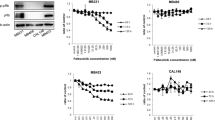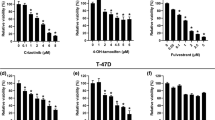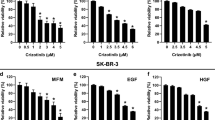Abstract
Estrogens induce breast tumor cell proliferation by directly regulating gene expression via the estrogen receptor (ER) transcriptional activity and by affecting growth factor signaling pathways such as mitogen-activated protein kinase (MAPK) and AKT/mammalian target of rapamycin Complex1 (mTORC1) cascades. In this study we demonstrated the preclinical therapeutic efficacy of combining the aromatase inhibitor letrozole with the multi-kinase inhibitor sorafenib in aromatase-expressing breast cancer cell lines. Treatment with letrozole reduced testosterone-driven cell proliferation, by inhibiting the synthesis of estrogens. Sorafenib inhibited cell proliferation in a concentration-dependent manner; this effect was not dependent on sorafenib-mediated inhibition of Raf1, but involved the down-regulation of mTORC1 and its targets p70S6K and 4E-binding protein 1 (4E-BP1). At concentrations of 5–10 μM the growth-inhibitory effect of sorafenib was associated with the induction of apoptosis, as indicated by release of cytochrome c and Apoptosis-Inducing Factor into the cytosol, activation of caspase-9 and caspase-7, and PARP-1 cleavage. Combination of letrozole and sorafenib produced a synergistic inhibition of cell proliferation associated with an enhanced accumulation of cells in the G0/G1 phase of the cell cycle and with a down-regulation of the cell cycle regulatory proteins c-myc, cyclin D1, and phospho-Rb. In addition, longer experiments (12 weeks) demonstrated that sorafenib may be effective in preventing the acquisition of resistance towards letrozole. Together, these results indicate that combination of letrozole and sorafenib might constitute a promising approach to the treatment of hormone-dependent breast cancer.






Similar content being viewed by others
References
Osborne CK, Shou J, Massarweh S, Schiff R (2005) Crosstalk between estrogen receptor and growth factor receptor pathways as a cause for endocrine therapy resistance in breast cancer. Clin Cancer Res 11:865s–870s
Bjornstrom L, Sjoberg M (2005) Mechanisms of estrogen receptor signaling: convergence of genomic and nongenomic actions on target genes. Mol Endocrinol 19:833–842
Migliaccio A, Di Domenico M, Castoria G et al (1996) Tyrosine kinase/p21ras/MAP-kinase pathway activation by estradiol-receptor complex in MCF-7 cells. EMBO J 15:1292–1300
Le Goff P, Montano MM, Schodin DJ, Katzenellenbogen BS (1994) Phosphorylation of the human estrogen receptor. Identification of hormone-regulated sites and examination of their influence on transcriptional activity. J Biol Chem 269:4458–4466
Kato S, Endoh H, Masuhiro Y et al (1995) Activation of the estrogen receptor through phosphorylation by mitogen-activated protein kinase. Science 270:1491–1494
Smith IE, Dowsett M (2003) Aromatase inhibitors in breast cancer. N Engl J Med 348:2431–2442
Haynes BP, Dowsett M, Miller WR, Dixon JM, Bhatnagar AS (2003) The pharmacology of letrozole. J Steroid Biochem Mol Biol 87:35–45
Bhatnagar AS (2006) Review of the development of letrozole and its use in advanced breast cancer and in the neoadjuvant setting. Breast 15(Suppl 1):S3–S13
Schiff R, Massarweh SA, Shou J, Bharwani L, Mohsin SK, Osborne CK (2004) Cross-talk between estrogen receptor and growth factor pathways as a molecular target for overcoming endocrine resistance. Clin Cancer Res 10:331S–336S
Johnston SR, Martin LA, Leary A, Head J, Dowsett M (2007) Clinical strategies for rationale combinations of aromatase inhibitors with novel therapies for breast cancer. J Steroid Biochem Mol Biol 106:180–186
Gligorov J, Azria D, Namer M, Khayat D, Spano JP (2007) Novel therapeutic strategies combining antihormonal and biological targeted therapies in breast cancer: focus on clinical trials and perspectives. Crit Rev Oncol Hematol 64:115–128
Generali D, Buffa FM, Berruti A et al (2009) Phosphorylated ERalpha, HIF-1alpha, and MAPK signaling as predictors of primary endocrine treatment response and resistance in patients with breast cancer. J Clin Oncol 27:227–234
Kane RC, Farrell AT, Saber H et al (2006) Sorafenib for the treatment of advanced renal cell carcinoma. Clin Cancer Res 12:7271–7278
Kane RC, Farrell AT, Madabushi R et al (2009) Sorafenib for the treatment of unresectable hepatocellular carcinoma. Oncologist 14:95–100
Wilhelm SM, Carter C, Tang L et al (2004) BAY 43-9006 exhibits broad spectrum oral antitumor activity and targets the RAF/MEK/ERK pathway and receptor tyrosine kinases involved in tumor progression and angiogenesis. Cancer Res 64:7099–7109
Plaza-Menacho I, Mologni L, Sala E et al (2007) Sorafenib functions to potently suppress RET tyrosine kinase activity by direct enzymatic inhibition and promoting RET lysosomal degradation independent of proteasomal targeting. J Biol Chem 282:29230–29240
Sharma A, Trivedi NR, Zimmerman MA, Tuveson DA, Smith CD, Robertson GP (2005) Mutant V599 EB-Raf regulates growth and vascular development of malignant melanoma tumors. Cancer Res 65:2412–2421
Liu L, Cao Y, Chen C et al (2006) Sorafenib blocks the RAF/MEK/ERK pathway, inhibits tumor angiogenesis, and induces tumor cell apoptosis in hepatocellular carcinoma model PLC/PRF/5. Cancer Res 66:11851–11858
Panka DJ, Wang W, Atkins MB, Mier JW (2006) The Raf inhibitor BAY 43-9006 (Sorafenib) induces caspase-independent apoptosis in melanoma cells. Cancer Res 66:1611–1619
Huether A, Hopfner M, Baradari V, Schuppan D, Scherubl H (2007) Sorafenib alone or as combination therapy for growth control of cholangiocarcinoma. Biochem Pharmacol 73:1308–1317
Rahmani M, Davis EM, Bauer C, Dent P, Grant S (2005) Apoptosis induced by the kinase inhibitor BAY 43-9006 in human leukemia cells involves down-regulation of Mcl-1 through inhibition of translation. J Biol Chem 280:35217–35227
Ding Q, Huo L, Yang JY et al (2008) Down-regulation of myeloid cell leukemia-1 through inhibiting Erk/Pin 1 pathway by sorafenib facilitates chemosensitization in breast cancer. Cancer Res 68:6109–6117
Huynh H, Ngo VC, Koong HN et al (2009) Sorafenib and rapamycin induce growth suppression in mouse models of hepatocellular carcinoma. J Cell Mol Med. doi:10.1111/j.1582-4934.2009.00692.x
Kumar SM, Yu H, Edwards R et al (2007) Mutant V600E BRAF increases hypoxia inducible factor-1alpha expression in melanoma. Cancer Res 67:3177–3184
Macaulay VM, Nicholls JE, Gledhill J, Rowlands MG, Dowsett M, Ashworth A (1994) Biological effects of stable overexpression of aromatase in human hormone-dependent breast cancer cells. Br J Cancer 69:77–83
Banerjee S, Zvelebil M, Furet P et al (2009) The vascular endothelial growth factor receptor inhibitor PTK787/ZK222584 inhibits aromatase. Cancer Res 69:4716–4723
Cavazzoni A, Petronini PG, Galetti M et al (2004) Dose-dependent effect of FHIT-inducible expression in Calu-1 lung cancer cell line. Oncogene 23:8439–8446
Fumarola C, La Monica S, Alfieri RR, Borra E, Guidotti GG (2005) Cell size reduction induced by inhibition of the mTOR/S6K-signaling pathway protects Jurkat cells from apoptosis. Cell Death Differ 12:1344–1357
Goldoni M, Johansson C (2007) A mathematical approach to study combined effects of toxicants in vitro: evaluation of the Bliss independence criterion and the Loewe additivity model. Toxicol In Vitro 21:759–769
La Monica S, Galetti M, Alfieri RR et al (2009) Everolimus restores gefitinib sensitivity in resistant non-small cell lung cancer cell lines. Biochem Pharmacol 78:460–468
Aesoy R, Sanchez BC, Norum JH, Lewensohn R, Viktorsson K, Linderholm B (2008) An autocrine VEGF/VEGFR2 and p38 signaling loop confers resistance to 4-hydroxytamoxifen in MCF-7 breast cancer cells. Mol Cancer Res 6:1630–1638
Lathia C, Lettieri J, Cihon F, Gallentine M, Radtke M, Sundaresan P (2006) Lack of effect of ketoconazole-mediated CYP3A inhibition on sorafenib clinical pharmacokinetics. Cancer Chemother Pharmacol 57:685–692
Strumberg D, Clark JW, Awada A et al (2007) Safety, pharmacokinetics, and preliminary antitumor activity of sorafenib: a review of four phase I trials in patients with advanced refractory solid tumors. Oncologist 12:426–437
Gatti R, Belletti S, Orlandini G, Bussolati O, Dall’Asta V, Gazzola GC (1998) Comparison of annexin V and calcein-AM as early vital markers of apoptosis in adherent cells by confocal laser microscopy. J Histochem Cytochem 46:895–900
Kagawa S, Gu J, Honda T et al (2001) Deficiency of caspase-3 in MCF7 cells blocks Bax-mediated nuclear fragmentation but not cell death. Clin Cancer Res 7:1474–1480
Oliver FJ, de la Rubia G, Rolli V, Ruiz-Ruiz MC, de Murcia G, Murcia JM (1998) Importance of poly(ADP-ribose) polymerase and its cleavage in apoptosis. Lesson from an uncleavable mutant. J Biol Chem 273:33533–33539
O’Reilly KE, Rojo F, She QB et al (2006) mTOR inhibition induces upstream receptor tyrosine kinase signaling and activates Akt. Cancer Res 66:1500–1508
Belosay A, Brodie AM, Njar VC (2006) Effects of novel retinoic acid metabolism blocking agent (VN/14-1) on letrozole-insensitive breast cancer cells. Cancer Res 66:11485–11493
Wilhelm S, Chien DS (2002) BAY 43-9006: preclinical data. Curr Pharm Des 8:2255–2257
Yu C, Bruzek LM, Meng XW et al (2005) The role of Mcl-1 downregulation in the proapoptotic activity of the multikinase inhibitor BAY 43-9006. Oncogene 24:6861–6869
Tran MA, Smith CD, Kester M, Robertson GP (2008) Combining nanoliposomal ceramide with sorafenib synergistically inhibits melanoma and breast cancer cell survival to decrease tumor development. Clin Cancer Res 14:3571–3581
Molhoek KR, Brautigan DL, Slingluff CL Jr (2005) Synergistic inhibition of human melanoma proliferation by combination treatment with B-Raf inhibitor BAY43-9006 and mTOR inhibitor Rapamycin. J Transl Med 3:39
Carracedo A, Ma L, Teruya-Feldstein J et al (2008) Inhibition of mTORC1 leads to MAPK pathway activation through a PI3K-dependent feedback loop in human cancer. J Clin Invest 118:3065–3074
DeNardo DG, Cuba VL, Kim H, Wu K, Lee AV, Brown PH (2007) Estrogen receptor DNA binding is not required for estrogen-induced breast cell growth. Mol Cell Endocrinol 277:13–25
Shi Y, Sharma A, Wu H, Lichtenstein A, Gera J (2005) Cyclin D1 and c-myc internal ribosome entry site (IRES)-dependent translation is regulated by AKT activity and enhanced by rapamycin through a p38 MAPK- and ERK-dependent pathway. J Biol Chem 280:10964–10973
Zhou J, Wulfkuhle J, Zhang H et al (2007) Activation of the PTEN/mTOR/STAT3 pathway in breast cancer stem-like cells is required for viability and maintenance. Proc Natl Acad Sci USA 104:16158–16163
Nicholson RI, McClelland RA, Robertson JF, Gee JM (1999) Involvement of steroid hormone and growth factor cross-talk in endocrine response in breast cancer. Endocr Relat Cancer 6:373–387
Acknowledgments
We thank Bayer HealthCare Pharmaceuticals for providing sorafenib. Grant support: Associazione Davide Rodella, Montichiari (BS); Lega Italiana per la lotta contro i tumori, Parma; A.VO.PRO.RI.T., Parma; Fondazione Banca Popolare di Cremona; CONAD, Bologna (Italy).
Author information
Authors and Affiliations
Corresponding author
Additional information
Mara A. Bonelli and Claudia Fumarola contributed equally to this work.
Dean Evans is employed by Novartis Pharma AG.
Rights and permissions
About this article
Cite this article
Bonelli, M.A., Fumarola, C., Alfieri, R.R. et al. Synergistic activity of letrozole and sorafenib on breast cancer cells. Breast Cancer Res Treat 124, 79–88 (2010). https://doi.org/10.1007/s10549-009-0714-5
Received:
Accepted:
Published:
Issue Date:
DOI: https://doi.org/10.1007/s10549-009-0714-5




